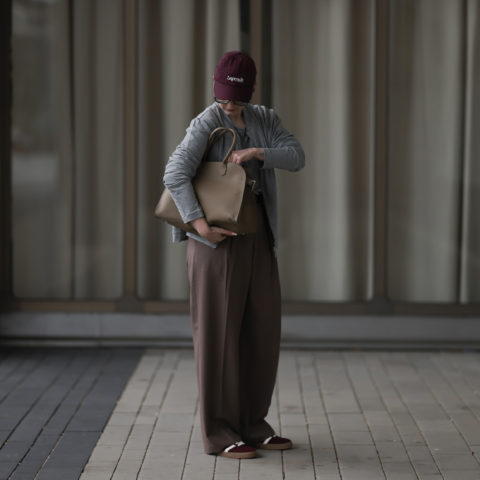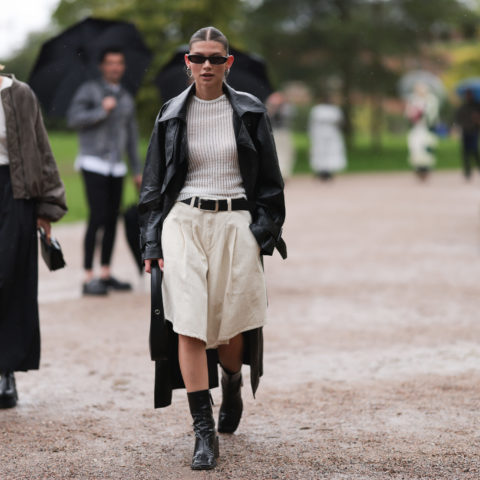How This Shoe Designer Quit Her Fast Fashion Habit
"I shop differently now... I build my wardrobe as opposed to stocking my closet for the season."
As one of the two founders of indie shoe brand Freda Salvador (which counts Cate Blanchett, Jennifer Lawrence and Gina Rodriguez as fans), Megan Papay understands both the struggles and thrills of running a small business. An admirer of small brands like her own—which she runs in Sausalito, California, with co-founder Cristina Palomo-Nelson—Papay started to become increasingly frustrated seeing the work of these little-labels-that-could get ripped off by fast fashion brands. In her resolve to support independent businesses, Papay made a commitment to patronize brands and boutiques that fell under one of three categories: vintage, local or consignment.
Over the course of two years, that experiment turned into a way of life, with Papay documenting her journey on an Instagram account dedicated to the purpose: @TheVCLProject. Now, her shopping habits have changed forever, thanks to a more mindful relationship with her wardrobe and a more responsible approach to consumerism. If you’re looking for a New Year’s resolution for 2019 that reduces your environmental impact, this might just be it. Read on to learn more about Papay’s experience off the fast fashion track.
Where did the idea for The VCL Project come from?
I run Freda Salvador’s social media and spend a lot of time on Instagram following other brands, large and small. Because little brands have so much power now, their audience can grow fairly quickly, and I remember seeing little brands that I’d been rooting for along the way getting knocked off by bigger brands. I know it happens all the time, in fast fashion, brands copy each other but it started making me increasingly sad and angry that these tiny brands are getting their products knocked off on Instagram. I have so much passion for supporting young makers and people like Cristina and I, just living out our dreams and making so many sacrifices along the way. So I was like I don’t want to buy that stuff anymore but I do want to support local, small businesses. I want to know where the product is coming from, I want to know who’s making it, and why. So that was the impetus behind it.
Does shopping like this require more effort on your part, and a more mindful strategy going into it?
It does but I enjoy it. It’s so much more fun for me. Before, I never enjoyed going to a mall and shopping at Zara. I’d be like ‘ugh I hate everything in my closet, I just need something new’ so I’d just pop in and bring like 30 pieces to the dressing room. The whole thing was not a pleasant experience from start to finish and I never really felt that good even when I got the pieces. It’s like, ‘I feel cuter but it’s nothing I’m overly psyched about.’ Now the experience is so much more pleasant and you never know what you’re going to find. Vintage is a passion of mine, and so is consignment and locally made clothing. I’m on my second year of it and I’ve never been tempted to look at or even think about [fast fashion] anymore.
Sometimes when things are really cheap you don’t think twice before buying them and then next thing you know you have a closet full of things you’ve only worn once and have no connection to. Did you end up getting rid of all your stuff from before when you began this project?
I did a huge purge but I still have some of the things that were just good quality or had sentimental value. If I love them I’m still going to wear them. I definitely have a lot of pants and old sweaters that I never want to get rid of.
Was the environment something you thought about going into this, about the positive impact of sustainable shopping?
Yes, absolutely. When I would do closet cleanses, I realised I was giving so much stuff away. Bags and bags of clothes. It was so cheap and easy to get rid of and part with. Things kept coming and going so quickly, and I’d make myself feel better by saying ‘oh I’m passing it on to someone.’ But if everyone has eight bags of clothes every year they’re giving away, it’s just so much. I realised there had to be a better way.
Even when you give stuff away, those places don’t know what to do with it because they’re just getting so much of it all the time.
It’s so true. I was dropping some things off at Goodwill once and I had categorized it into my stuff, my daughter’s sweaters, etc and the guy there was like ‘that was really nice of you.’ Often times people just bring piles of stuff, which they don’t always have the time to sort through and so it gets shipped to the next place which is most likely a landfill.
What did you learn about yourself and how you dress through this process?
I’m so much more adventurous in my style because I have better things. I have pieces that speak to me. You fall in love with each piece as opposed to trying to put whole outfits together. My closet is very wearable now, because there’s no set “outfit,” it’s just a collection of great pieces. Plus, my style’s better because I don’t have the same things that everyone else has.
So do you think your approach to shopping has changed for good?
Yes. I shop differently now. I’m not going out looking for specific things anymore, I just buy what I fall in love with, if it’s in my price range, and I build my wardrobe as opposed to stocking my closet for the season. It’s changed my whole perception of my closet.
What advice would you give to people wanting to try this for themselves?
Just plant the seeds. You don’t have to change your whole wardrobe; even if it’s 80/20 or 60/40, it’s a step in the right direction.








